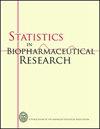关于临床试验分析中分层误差的说明
IF 1.5
4区 医学
Q3 MATHEMATICAL & COMPUTATIONAL BIOLOGY
引用次数: 0
摘要
随机临床试验的设计和分析中的分层是常见的。尽管自动随机化系统具有重新确认分层变量的功能,但可能会输入这些变量的错误值。这些错误通常在随后的数据收集和验证过程中被检测到。在随后的分析中,是使用错误报告的初始分层还是使用校正值仍然存在问题。结果表明,随机临床试验设计产生的似然函数支持校正值的使用。提出了新的定义,将错误分类错误描述为“可忽略”和“不可忽略”。可忽略的误差可能取决于正确的地层和任何其他建模的基线协变量,但它们与潜在的治疗结果无关。数据管理审查表明,大多数错误分类错误是由分心的研究人员任意产生的,因此它们是可忽略的,或者至多是弱依赖于测量和未测量的基线协变量。可忽略的错误分类误差可能会导致标准误差的小幅增加,但计划分析的其他特性不变(例如,无偏性、置信区间覆盖率)。结果表明,当存在不可忽略的误分类误差时,在没有误分类误差的情况下的无偏线性估计保持无偏,并且基于校正的地层值的相应置信区间是保守的。本文章由计算机程序翻译,如有差异,请以英文原文为准。
A note on stratification errors in the analysis of clinical trials
Stratification in both the design and analysis of randomized clinical trials is common. Despite features in automated randomization systems to re-confirm the stratifying variables, incorrect values of these variables may be entered. These errors are often detected during subsequent data collection and verification. Questions remain about whether to use the mis-reported initial stratification or the corrected values in subsequent analyses. It is shown that the likelihood function resulting from the design of randomized clinical trials supports the use of the corrected values. New definitions are proposed that characterize misclassification errors as `ignorable' and `non-ignorable'. Ignorable errors may depend on the correct strata and any other modeled baseline covariates, but they are otherwise unrelated to potential treatment outcomes. Data management review suggests most misclassification errors are arbitrarily produced by distracted investigators, so they are ignorable or at most weakly dependent on measured and unmeasured baseline covariates. Ignorable misclassification errors may produce a small increase in standard errors, but other properties of the planned analyses are unchanged (e.g., unbiasedness, confidence interval coverage). It is shown that unbiased linear estimation in the absence of misclassification errors remains unbiased when there are non-ignorable misclassification errors, and the corresponding confidence intervals based on the corrected strata values are conservative.
求助全文
通过发布文献求助,成功后即可免费获取论文全文。
去求助
来源期刊

Statistics in Biopharmaceutical Research
MATHEMATICAL & COMPUTATIONAL BIOLOGY-STATISTICS & PROBABILITY
CiteScore
3.90
自引率
16.70%
发文量
56
期刊介绍:
Statistics in Biopharmaceutical Research ( SBR), publishes articles that focus on the needs of researchers and applied statisticians in biopharmaceutical industries; academic biostatisticians from schools of medicine, veterinary medicine, public health, and pharmacy; statisticians and quantitative analysts working in regulatory agencies (e.g., U.S. Food and Drug Administration and its counterpart in other countries); statisticians with an interest in adopting methodology presented in this journal to their own fields; and nonstatisticians with an interest in applying statistical methods to biopharmaceutical problems.
Statistics in Biopharmaceutical Research accepts papers that discuss appropriate statistical methodology and information regarding the use of statistics in all phases of research, development, and practice in the pharmaceutical, biopharmaceutical, device, and diagnostics industries. Articles should focus on the development of novel statistical methods, novel applications of current methods, or the innovative application of statistical principles that can be used by statistical practitioners in these disciplines. Areas of application may include statistical methods for drug discovery, including papers that address issues of multiplicity, sequential trials, adaptive designs, etc.; preclinical and clinical studies; genomics and proteomics; bioassay; biomarkers and surrogate markers; models and analyses of drug history, including pharmacoeconomics, product life cycle, detection of adverse events in clinical studies, and postmarketing risk assessment; regulatory guidelines, including issues of standardization of terminology (e.g., CDISC), tolerance and specification limits related to pharmaceutical practice, and novel methods of drug approval; and detection of adverse events in clinical and toxicological studies. Tutorial articles also are welcome. Articles should include demonstrable evidence of the usefulness of this methodology (presumably by means of an application).
The Editorial Board of SBR intends to ensure that the journal continually provides important, useful, and timely information. To accomplish this, the board strives to attract outstanding articles by seeing that each submission receives a careful, thorough, and prompt review.
Authors can choose to publish gold open access in this journal.
 求助内容:
求助内容: 应助结果提醒方式:
应助结果提醒方式:


